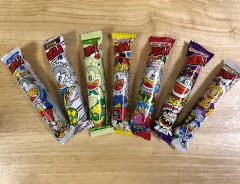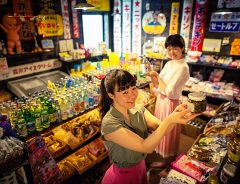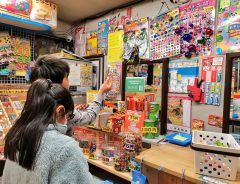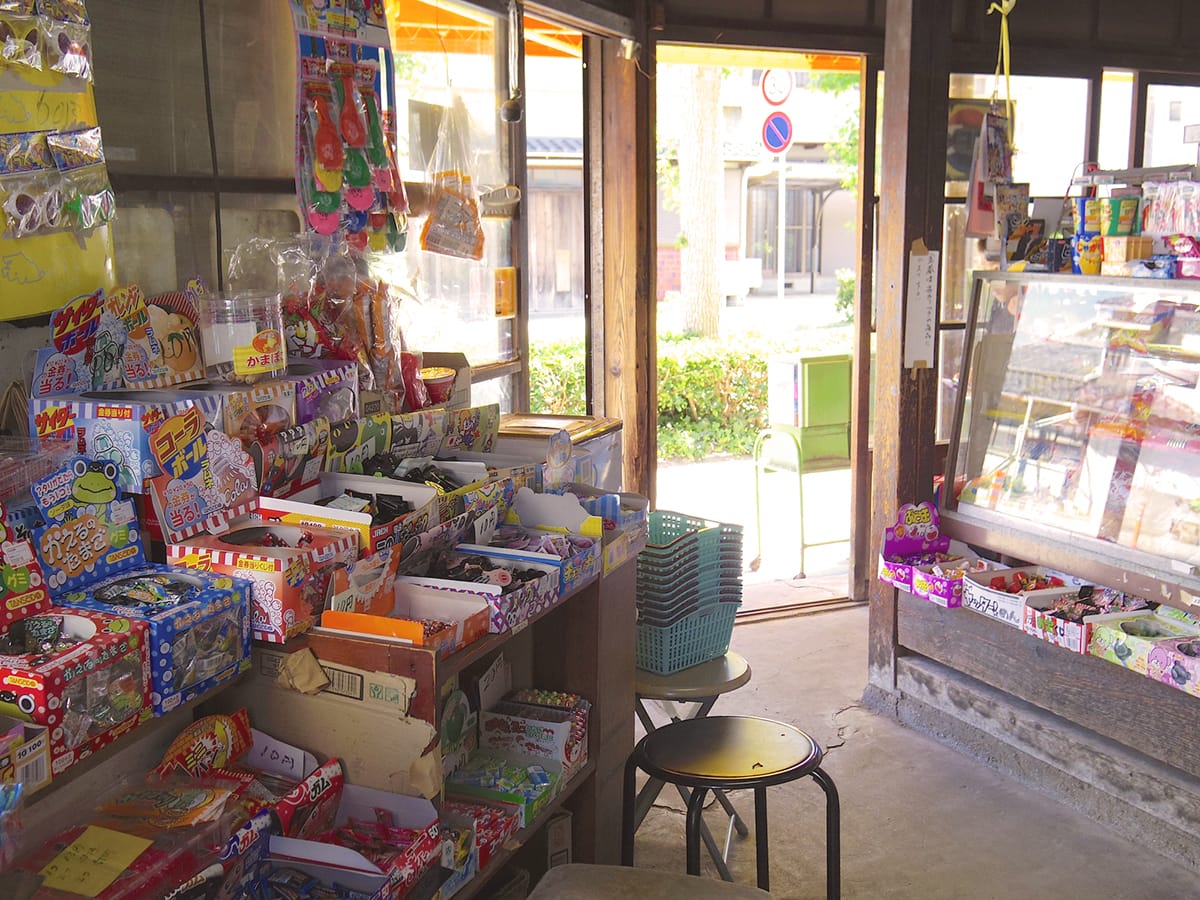- Tags:
- dagashi / News Crossing / withnews
Related Article
-

Dagashi review: We tried 7 flavors of Umaibō, Japan’s top “tasty stick” snack [News Crossing]
-

Try Japanese School Lunches From Meiji to Heisei Era At Retro Showa Tamagawa Onsen
-

The current state of dagashi: What Japan is losing along with its dagashi shops [News Crossing]
-

Showa retro vibes in the nostalgic Tokyo neighborhood of Shibamata: Top places to visit



Far from worthless
The first time I stepped into a dagashi ("penny snack") shop, I was driven by curiosity. I was on my way to visit the Arakawa Amusement Park, an old-fashioned theme park that most people reach by taking Tokyo's last remaining trolley line, the Toden Arakawa Line. On the street leading to the park from Arakawa Yuen Station, a shop with a sign 「こどもの家 きくや」or "Children's House Kikuya" caught my attention.
Inside, there were shelves filled will all manner of candy, sweets, and snacks the likes of which I had never seen before. As the early afternoon sun gently filtered in, I kneeled down to take a closer look. Some of the candies and snacks I had seen before in Japanese convenience stores, but others were totally unfamiliar. Just as I was about to leave, a middle-aged couple and their daughter (or perhaps granddaughter) walked in. "How nostalgic," I heard the woman say.
I was both excited to discover an aspect of Japanese culture I knew nothing about, and also somehow jealous of the nostalgia she expressed, nostalgia for a childhood memory which I didn't share since I wasn't raised in Japan, but now suddenly felt eager to discover.
I would later learn that dagashi 駄菓子 is written with kanji literally meaning "worthless snack," a name which it earned in the Edo period to distinguish the cheap confections made with assorted cereal grains and sugars from high-class wagashi. However, for me, as well as for many foreigners who discover them, dagashi are far from worthless.
Whether it's their cute shapes or fun packaging, often featuring illustrations and characters, and sometimes even riddles and quizzes, or their astonishing variety of types and flavors both sweet and savory, or the Showa Era mood of the shops where they are sold, dagashi are like gems in a treasure chest, each one with its own appeal and history. For some people, they are coated with the dust of nostalgia, for others, they are as shiny and new as a capsule toy fresh from the dispenser, waiting to be discovered and tasted.
Inside a dagashi store. | 長兵衛 Chōbē | © PIXTA
Sadly, after half a century in business, Children's House Kikuya closed its doors in 2018. Although they used to be a common sight in cities throughout Japan, the number of dagashi stores are dwindling year by year. But dagashi are not in danger of disappearing any time soon. In various ways, dagashi and dagashi culture are adapting to the changing times.
grape Japan and withnews [a web media operated by Asahi Shimbun] have teamed up for a joint project called "News Crossing," a new series in which writers from different nationalities and backgrounds converge on a single facet of Japanese culture or a city neighborhood to share opinions and insights.
In the first installment, we take you to a cultural crossroads exploring a variety of perspectives on the theme of dagashi.
[News Crossing] Related articles
Are you learning Japanese? You can read the Japanese version of this article here on withnews:
「無価値とはほど遠い」 アニメが世界に発信した駄菓子の真価
Dagashi doldrums
Many Japanese people who were born in the Showa Era have fond childhood memories of stopping by a dagashi store with their friends and filling a bag with penny sweets. It was also a social gathering place.
However, due to a combination of factors, dagashi stores are becoming scarcer and scarcer.
To begin with, there's the dagashi store's main customer base. Japan's rapidly aging society means fewer children to buy those "penny sweets." Moreover, the growing appeal of health-conscious lifestyles in the past two decades has meant that parents have become warier of dagashi, many of which have much in common with junk food.
But going back further to the late Showa Era, convenience stores began to compete for the attention of candy manufacturers. According to the Ministry of Economy, Trade, and Industry, the number of establishments in the confectionery retail industry, which includes dagashi stores, decreased by 70% between 1982 and 2002, dropping to about 14,000.1
An additional reason was the spread of video games and arcades which vied for children's attention. Kids were more likely to spend time playing games than hanging out at the dagashi store.
Sadly, with the current novel coronavirus pandemic, there's another reason why children may be discouraged from visiting a dagashi store. Some adults seem to take issue with their role as gathering places. Last year, a dagashi store in Chiba Prefecture found a sign one day with the threatening message: "Don't gather kids. Close your store. It's a waste of masks."2 One can only hope that with the end of the pandemic, both parents and their children will gain a renewed appreciation for dagashi stores as they rediscover the freedom to gather there and enjoy themselves.
Finally, like many other traditional businesses in Japan, the appeal of running a dagashi shop has faded, especially for the younger generation. When children aren't interested in taking over the family business, shops have been forced to close their doors when their owners retire or pass away.
Dagashi dreams
And yet, there are a few beams of sunshine peeking through the clouds.
For one thing, adults who have fond memories of dagashi and dagashi stores are contributing to their survival. Nostalgia for the Showa Era has created new opportunities.
One of them is the dagashi bar. Usually combined with a retro Showa interior, these bars which have popped up in several cities offer nostalgic dagashi sweets and snacks, sometimes in an all-you-can-eat deal, to enjoy with an alcoholic beverage (or soft drink) of your choice. The most famous one is simply called Dagashi Bar. Opening in 1998 in Ebisu, it is now a chain with two other locations in Shinjuku and Shibuya.
Dagashi makers aren't sitting idle either. While some of the dagashi which were launched in the Showa Era are no longer available, others have managed to adapt to the times.
For example, since 2011, Orion's ココアシガレット "Cocoa Cigarettes" have actively worked on changing their image from a product which encourages children to smoke to a product geared towards adults trying to quit smoking. In 2018, they even created a new kind of candy cigarette called "my Cos" inspired by e-cigarettes with a strong menthol taste.
Or consider 共親製菓 Kyōshin Seika Co., famous for the cherry-flavored tablet candy Sakuranbo-mochi, a staple of dagashi stores since 1979. In 2013, they launched a new tablet candy called たべプリ Tabepuri inspired by smartphones to appeal to a new generation of kids.3
Many types of dagashi are available at convenience stores, and those that you can't find at your local store can often be ordered through Amazon (US / JP) and other online retailers.
Discovering dagashi through anime
Although my first encounter with dagashi was through my own experience in Japan, for many foreigners who have yet to visit this country, their first glimpse of dagashi may have been through anime, especially if they were into anime some time in the last five years or so.
In fact, you could say that 2016 was a watershed year in raising dagashi's international profile.
Let's begin with the most obvious one, 「だがしかし」Dagashi Kashi, since dagashi is the central subject it deals with. A manga written and illustrated by Kotoyama and serialized in Shogakukan's Weekly Shōnen Sunday, it was adapted into an anime which aired in Japan from January 2016, and was followed by a second season. Outside of Japan, anime fans would have watched the series on Crunchyroll from 2016.
The slice-of-life / comedy story about young man uninterested in heeding his father's wishes for him to take over his family dagashi shop, but who then meets a cute but strange girl who begins visiting the shop day after day in an effort to convince him otherwise, is not only a wonderful introduction to dagashi, it also highlights the current predicament faced by real dagashi stores today.
There are surely viewers who have taken it upon themselves to order some of the dagashi introduced in the series, or who were tempted to try them when they visit Japan.
At grape Japan, we were inspired to buy some Umaibō, (Tasty Sticks) puffed snacks introduced in the beginning of the series (Chapter 1 of the manga, Episode 1 of Season 1 of the anime) as well as Big Katsu, introduced in Book 5 Chapter 88 of the manga and Episode 6 in Season 1 of the anime. (Look for our review of Umaibō in our article here)
2016 is also the year that Studio Ghibli's 1991 film Only Yesterday, directed by Isao Takahata, finally had a theatrical release in North America by GKIDS and was made into a DVD and Bluray by GKIDS/Universal Pictures Home Entertainment with English dubbing (original Japanese soundtrack also available). The dagashi shop appears in the bittersweet memories of the protagonist Taeko's childhood in Yamagata, where it functions as a symbol of the nostalgic Showa Era landscape of her youth.
Those who live in or expect to visit the Tokyo area will be happy to know that the dagashi store depicted in the film is said to have a real-life model there. 上川口屋 Kami-kawaguchiya, Tokyo's oldest operating dagashi store with a 240-year history stretching back to the Edo period, is located on the grounds of Tokyo’s Kishibojin Shrine. Just like the now-defunct Children's House Kikuya, it's also accessible through the Toden Arakawa streetcar line.
Kami-kawaguchiya which is said to be the model for the dagashiya in Only Yesterday | torne (where's my lens cap?), CC BY 2.0, via Wikimedia Commons
There's one more reference, or rather a meta-reference, worth mentioning, and that's Dennō Coil. Produced by Madhouse, the anime marked Mitsuo Iso's directorial debut and premiered on NHK Educational TV in 2007.
Our readers in Australia and New Zealand may have seen it first since Siren Visual already released a box set in 2012 (re-released in 2014), but in North America, it was 2016 when Maiden Japan released it in DVD and Blu-ray.
In this science-fiction anime set in near-future Japan where people use semi-immersive augmented reality glasses to navigate a city which is half-virtual, protagonist Yuko (Yasako) joins her grandmother’s “investigation agency” comprised of children. Grandma Megabaa's shop, "Megashiya," is described as a dennō dagashiya 電脳駄菓子屋 in other words a cyber-dagashiya shop. Instead of candies and snacks, however, she sells powerful metatags and software which are used by the child protagonists to access and manipulate the virtual world in ways which are unapproved by the adult administrators.
In this respect, perhaps a common thread can be tied between Dennō Coil's Megashiya and today's dagashiya. In their own ways, they offer a site of resistance to the encroachment of adulthood on the realm of childhood.
grape Japan writer survey
We surveyed three of our writers on dagashi. Here's a sample of their replies:
Q: Which dagashi have you tried and which ones do you like? Do you have a favorite brand or a favorite type?
Connie Sceaephierde (United Kingdom):
"As someone with a sweet-tooth, I tend to prefer candied and sugary snacks (Morinaga Choco Ball, Meiji Choco Baby, Meiji Candy Tablets, Sakuma Drops, Tirol Chocolate) to the savoury ones (Umaibo, Kabayakisan Taro, Big Katsu). I would have to list my favourite as the small chocolate treats like Tirol Chocolate."
cinnamonellie (Romania):
"I have tried a lot of dagashi, and the ones I eat more often are: Sakura daikon, Umaibou, Tirol choco, Yocchan ika, sukonbu, candy cigarettes, kyabetsu taro, daifuku, konpeito, kozakura mochi, and Kabayakisan Taro. However, I do like to buy konpeito now and then, too, not necessarily for the flavor, but because they look so cute. Also, because when I was younger, I saw these candies in one of my favorite series, Paradise Kiss, so ever since, I like putting them in a jar, and having them on top of my kitchen table."
Jen Laforteza (Philippines):
"The types of dagashi I’ve tried and enjoy are more on the salty side. My favorites, in particular, are Umaibou and Kyabetsu Taro."
Q: What do you like about dagashi (and dagashi shops)?
Connie Sceaephierde (United Kingdom):
"With low prices, and the attractiveness of dagashi snacks' somewhat historical value, you can understand why many people enjoy dagashi and the rare dagashiya shops. For foreigners who visit Japan, trying a range of well-known dagashi treats is often high on their list, and is also a relatively easy thing to achieve due to the snacks' cheap pricing and the ease of finding dagashi snacks in stores such as Don Quijote or any supermarket's sweets section."
Jen Laforteza (Philippines):
"I like dagashi shops because they remind me of a 'sari-sari store' from back home in the Philippines. The name translates to 'variety store,' and they're very similar to dagashi shops because everything they sell is inexpensive but they still offer you so many choices. Dagashi themselves remind me of snacks I would get from these stores growing up. So in addition to my love for snacking, I also really like dagashi because they're a sort of comfort food for me that reminds me of home."
Q. Is there anything similar to dagashi in your country?
cinnamonellie (Romania):
"I remember that back in the 90s, we had quite a variety of snacks similar to dagashi that we used to buy from small shops/kiosks. Besides the candy cigarettes, gum, chocolate money coins, and lolipops (especially Chupa Chups), we also had a few Romanian snacks that kids/adults often bought back then. One peculiar snack that I remember was the edible paper. I never tried it, but I remember my friends buying it from the store and sometimes eating it. I always found it weird."
So, what are your experiences with dagashi? Please share your thoughts and comments with us on our Facebook page.
Sources:
1. As cited in Nihon Keizai Shimbun. Aug. 21, 2017 ^
2. Asahi Shimbun, Aug. 16, 2020. ^
3. FNN Prime Online, April 3, 2019. ^
News Crossing: Related articles
Talk Event: Friday, July 16th 13:00 (JST)